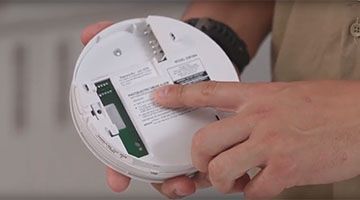6 August 2018
Queensland Smoke Alarm Legislation – What you need to know
How does the new Queensland smoke alarm legislation affect you? Lee speaks to Fallon Solutions electrician Joel will take you through the different stages and what you need to do to comply.
Queensland Smoke Alarm Legislation – What you need to know – video transcript
Lee: So we’re here with Joel today to talk about smoke alarms and the changes in legislation. Joel, what has actually changed?
Joel: Lee the Queensland Government has made some changes in smoke alarm legislation to make us safe in their own home. New legislation is calling for changes in the type of smoke alarm, how they are installed and how they operate. Currently, a lot of Queensland homes have ionization alarms the new legislation has called for interconnected photoelectric alarms.
Lee: Ok Joel what is the difference between ionization and a photoelectric smoke alarm?
Joel: Well most homes have ionization smoke alarms installed.
Ionization alarms work by feeling the smoke detecting invisible particles of combustion like when you burn your toast in the kitchen. This tendency to be triggered by false alarms mean that some people take the battery out there by losing protection. Ionization alarms activate quickly for fast flaming fires evidence suggests that ionization alarms are not as effective at detecting slow smouldering fires which are generally the fires that lead to deaths in homes.
Photoelectric alarms see the smoke by detecting visible particles of combustion and react more quickly to smouldering fires. They are more reliable and less likely to produce false alarm activations. When photoelectric alarms activate the smoke is still at the top layer of the ceiling and this gives residents more time to evacuate safely.
Lee: How can you tell what smoke alarms you’ve got?
Joel: Lee the easiest way is to grab your smoke alarm unclip it pull it down from the ceiling and actually physically look at the back of the smoke alarm to see what’s described. We can see this one here says photoelectric alarm so that complies with the new legislation. If your smoke alarms look slightly older or the home is slightly older again pull the smoke alarm away from the ceiling it will either say ionization or like this one it will show a radioactive symbol.
Lee: So Joel what’s involved in the legislation?
Joel: On January 1st 2017 every new or heavily modified building in Queensland needs to have interconnected hardwired photoelectric smoke alarms in each bedroom and the interconnecting hallways. For existing properties smoke alarms that were manufactured more than ten years ago must be replaced. If they are under ten years old but do not operate when tested they must also be replaced. In ten years all private homes and units will need hardwired, interconnected, photoelectric alarms installed. If a hardwired system cannot be installed they need to have a non-removable 10 year battery. They must be installed on each story in each bedroom and in hallways that connect bedrooms. If there is no hallway they need to be placed between the bedroom and other rooms on the story. If there are no bedrooms on a story at least one smoke alarm must be installed in the most likely exit path.
Lee: And the sole purpose of this legislation is most importantly to save lives.
Joel: That’s right Lee for more information you can head to Smoke Alarms or head to the Queensland Fire Emergency Services Website
Published: August 06, 2018 Last Updated: October 24, 2022

